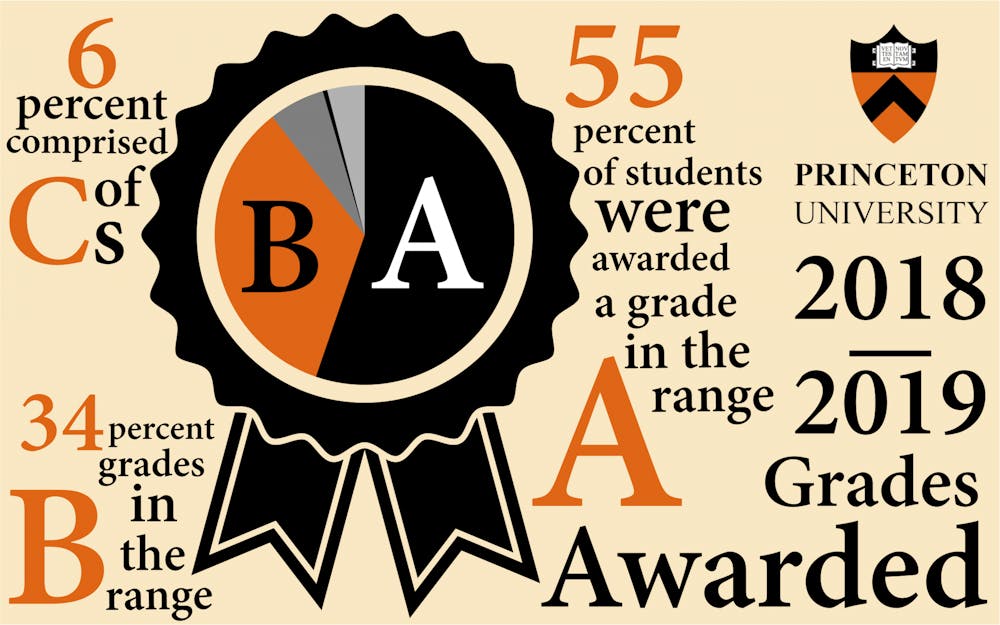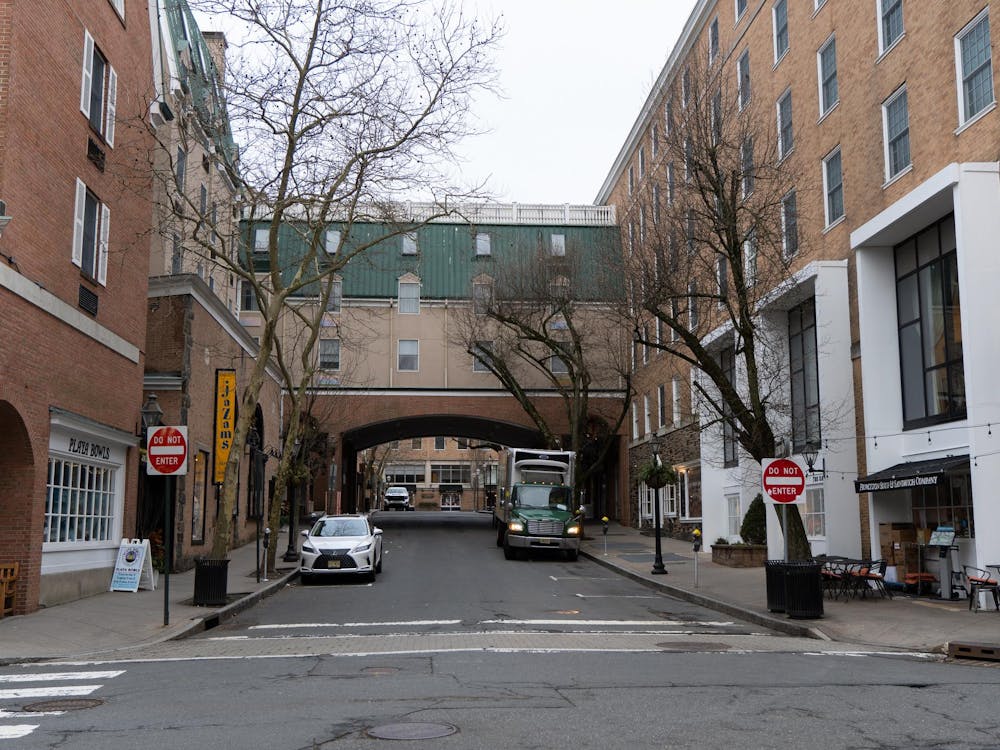Princeton has little to show for its experiment in “grade deflation,” except inflating grades that continue to lag behind those of its peer institutions.
I obtained restricted records from the Office of the Dean of the College on 120,000 grades awarded over the past three years at the nation’s top-ranked university. I confirmed their accuracy by comparing them to figures published in a recent memorandum.
The data are definitive: it’s never been easier to get an A at Princeton.
“Deflation worked, and then, when it went away, it had no long-term effect,” said professor Paul Courant GS ’74, an economist who viewed my statistics and co-authored a prior study on grades at the University of Michigan.
A- was the median grade in the 2018-2019 academic year. 55 percent of course grades were in the A-range. In 1998, they were 43 percent of course grades, according to a faculty report I acquired from Mudd Manuscript Library.
B-range grades comprised 34 percent, and the C-range comprised six percent. D’s were merely half a percent. A Princetonian’s chance of getting a F was one in a thousand. The remaining four percent went to “passes.”
But the proliferation of A’s isn’t as alarming as the many ways that students who are trying to maximize their grade point averages (GPAs) can game the system. Grades are full of quirks. The problem is that the outside world that assesses students for jobs and scholarships doesn’t seem to know or care about these nuances.
A struggling economics student takes a high-grading English seminar just to get an A. Graduates of elite high schools — there are tons of them here — receive advanced placements into upper-level classes, in which exam curves are more generous. C’s batter an engineer in her packed introductory courses; her grades might have been in the B-range if class sizes were smaller.

These scenarios play out every day at Princeton. Nobody would ever truly know what grades — especially GPAs — mean without understanding larger trends across the University.
As of last year, the college-wide GPA was 3.46. Yet using the average rate of inflation during 1985-2000, I projected that it would be approximately 3.63 today had deflation never occurred. That’s on par with Harvard’s 3.65 in 2016 and Yale’s 3.58 in 2012. Still, Princeton’s grades are inflating at roughly the same pace as they were in the late 1990s.

Graphic Courtesy of Charlotte Adamo / The Daily Princetonian

While deflation aimed to create “uniform grading standards” for academic departments, it didn’t affect them equally. The humanities’ course GPA tumbled 0.15 point when it was enacted, whereas the natural sciences hardly changed. Engineering and the social sciences each suffered a 0.10 point drop.
Grades have been 0.30-0.35 point higher in the humanities than in the natural sciences at least since 1985. But the gap narrowed to 0.20 point during the policy’s peak. Today, it has returned to 0.30.
A’s were the most common grade in all academic divisions. Over two-thirds of the humanities’ grades were in the A-range — C’s were virtually nonexistent — versus 46 percent in the natural sciences.
Although engineering and the natural sciences graded harsher, students were about twice as likely to earn an A+ in them as their classmates in other divisions. Unlike generic A’s, professors must file a special statement explaining why they’re giving an A+. Both are worth 4.0 points on the GPA scale.
“Even individual faculty within departments have very different practices in how they assign A+ grades,” an Office of the Dean of the College memo noted last fall. A+’s comprised one in twelve of Civil and Environmental Engineering’s grades. East Asian Studies gave none.

Slavic Languages and Literatures took the title of having the highest course GPA (3.75) among Princeton’s 36 departments. Music (3.69) came in second, and Comparative Literature (3.68) was third.
Chemistry (3.21) rounded off the bottom. Say goodbye to the phrase “rocks for jocks,” as Geosciences (3.22) was the next stingiest grader, following its second consecutive year of deflation. Slightly above, Mathematics tied with Mechanical and Aerospace Engineering (3.25).
Economics (3.34) was the sole department in the humanities and social sciences to have a course GPA lower than any of those in engineering and the natural sciences.
Classics led the charge for inflating its own grades, jumping nearly 0.20 points in one year. Anthropology and the Woodrow Wilson School trailed behind it with gains of 0.15 points and 0.09 points, respectively.
Mathematics, Computer Science, Economics, Chemistry, Physics, Mechanical and Aerospace Engineering, and Molecular Biology gave more C-range grades than the other 67 departments and programs combined, despite having one-third the number of students in their courses.
The humanities’ tendency toward higher grading than the sciences isn’t unique to Princeton. Courant discovered the same trend at the University of Michigan, while former Duke professor Stuart Rojstaczer has tracked it on a national scale.
“If a student’s grade point average is widely used for consequential purposes, differential grading standards might do a good deal of mischief,” Courant wrote in his study. Employers and selection committees often ignore them.
Most fellowships — including the Rhodes and Marshall — require candidates to have a minimum GPA of 3.7 regardless of their major. Perhaps it’s no coincidence that only one-fifth of Princeton’s American winners of these awards over the past decade majored in technical fields, according to press releases that I compiled.
Professional schools weed out applicants by their GPAs in addition to their standardized test scores. Trevor Klee ’15, an LSAT tutor, flat-out urged in the ‘Prince’ for undergraduates to “take easy classes and choose an easy major” so that they improve their odds of getting into prestigious law schools. Top jobs in finance are similar in their GPA expectations.
Course level had a surprising impact. Departments with low grades overall were more lenient in their advanced classes. Engineering and the natural sciences had the widest divides. In Mathematics, for example, the average grade was 3.15 for 100-200 level courses but was 3.65 for 300-400 level courses.
“People who aren’t good at math would just get murdered by the third semester of real analysis,” Courant said. He mused that advanced sciences classes have students who are already skilled in their subject and few who aren’t, driving up grades. Different exam curves must play a role as well, or else courses would give out the same percentage of A’s regardless of their level.
Courant also argued in his paper that large, mandatory courses have leeway to grade harshly because they don’t have to worry about losing students. Departments with low enrollments, in contrast, sometimes inflate their grades to attract students. I partially tested his claim by plotting GPAs against last year’s average course sizes, which I scraped from the registrar’s website. Departments that had larger classes on average indeed gave lower grades.
This course-level effect highlights the grading advantages that elite high school graduates enjoy. Their edge has particularly strong implications for technical subjects because science-oriented magnet schools — like Thomas Jefferson, Stuyvesant, and Bronx Science — send a lot of their seniors to Princeton.
The University’s advanced placement policy lets undergraduates start out in higher-level courses — above what first-years usually take — in which grading is more generous than at lower levels. Elite high schools provide the best preparation to score 5’s in AP exams, take upper level classes, and simply pass departments’ placement tests.
Likewise, if their graduates opt to retake an introductory course that they completed in high school, they will sit with classmates who have never seen the material before. As a result, graduates from elite high schools have a better chance of scoring on the exam curves’ upper ends.
It’s a win for elite high school graduates either way.
“While the Committee on Examinations and Standing follows grading data and reports to the faculty each year on trends, the responsibility for grading resides with departments and individual faculty,” Deputy University Spokesperson Michael Hotchkiss wrote in an email. Students don’t serve on the Committee. But he said that the Undergraduate Student Government’s (USG) Academics committee meets with it once per semester.
USG Academics Chair Olivia Ott ’20 declined my interview request.
All of these statistics demonstrate that the campus’ GPA obsession is ridiculous. Comparing a 3.7 to a 3.4 is pointless, since either could be the average or the exception within their departments.
Gordon Scharf ’09, along with University professors Robert Vanderbei and Daniel Marlow, proposed a new method to make grades more reflective of students’ performances. They created a dual regression model that corrected GPAs for inflation and courses’ difficulties. It would eliminate the need for policies like deflation that attempt to standardize grading — yet the registrar at the University is unlikely to implement it anytime soon.
Until then, the best thing to do would be to take Courant’s advice: ignore grades unless you know what they mean in a given field. He thought that they were “overused almost everywhere.” Professors’ letters of recommendation can make the “fine distinctions” — to borrow the words of a faculty memo — between “off scale, phenomenal and merely excellent students.”
“Undergraduates at Princeton have a pretty good life,” Courant told me. He lamented how “sad” it was that students spend too much energy trying to raise their GPAs instead of “taking the benefit of [a] wonderful liberal arts college.”
With deflation’s disappearance, Princetonians lost a reason to complain about grading. But they still lose sleep over it. I hope that this data will put an end to grade grubbing and help employers, scholarship committees, and graduate schools rethink how they judge their applicants.
If everyone focused on learning for the sake of learning, we wouldn’t worry about finding easy A’s to boost our GPAs.
(See more statistics on my Google Drive. The full grading reports from 2019 and 1998 are also available.)
Liam O’Connor is a senior geosciences major from Wyoming, Del. He can be reached at lpo@princeton.edu.








